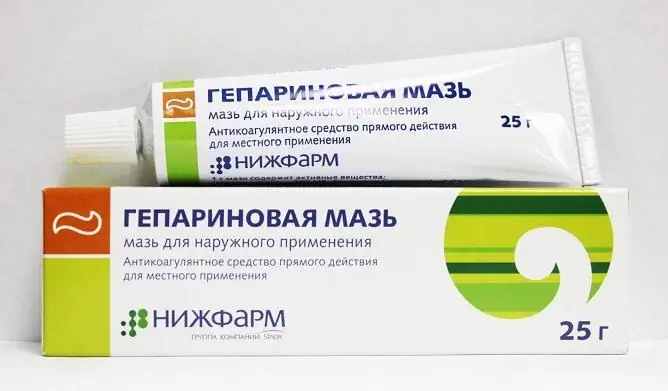- Author Rachel Wainwright [email protected].
- Public 2023-12-15 07:39.
- Last modified 2025-11-02 20:14.
Boromenthol
Boromenthol: instructions for use and reviews
- 1. Release form and composition
- 2. Pharmacological properties
- 3. Indications for use
- 4. Contraindications
- 5. Method of application and dosage
- 6. Side effects
- 7. Overdose
- 8. Special instructions
- 9. Application during pregnancy and lactation
- 10. Use in childhood
- 11. Drug interactions
- 12. Analogs
- 13. Terms and conditions of storage
- 14. Terms of dispensing from pharmacies
- 15. Reviews
- 16. Price in pharmacies
Latin name: Boromenthol
ATX code: R01AX30, M02AX
Active ingredient: boric acid + menthol (Boric Acid + Menthol)
Manufacturer: JSC "Borisov Plant of Medical Preparations" (Belarus); LLC "Ternopharm" (Ukraine)
Description and photo update: 2019-23-08

Boromenthol is a combined topical preparation with antiseptic and analgesic effects.
Release form and composition
Dosage form - ointment for external use: homogeneous, white or light yellow in color, has a characteristic odor (25 g each in cans; 25 g each in tubes without packs or in packs).
Active substances contained in 1 g of ointment:
- boric acid - 0.05 g;
- menthol - 0.005 g.
Auxiliary component: white soft paraffin.
Pharmacological properties
Pharmacodynamics
Boromenthol is a combined medicinal product, the effectiveness of which, when applied topically, is due to its constituent components:
- boric acid: has an antiseptic effect, has weak bacteriostatic and fungistatic properties;
- menthol: exhibits a local irritant (distracting) effect, expressed in a sensation of cold, slight tingling and burning.
Pharmacokinetics
Ointment Boromenthol when applied externally into the systemic circulation is practically not absorbed.
In this case, boric acid is able to be absorbed when the drug is applied to the skin, mucous membranes, wound surfaces and accidentally ingested ointment. The substance penetrates into many organs and tissues and tends to accumulate. It is excreted rather slowly, and in the case of repeated use, it can accumulate in the body. Approximately 50% of boric acid is excreted through the kidneys within 12 hours, the rest - within 5-7 days.
Indications for use
- itchy skin;
- neuralgia;
- rhinitis.
Contraindications
- severe renal dysfunction;
- children under 3 years old;
- pregnancy and lactation period;
- hypersensitivity to any component of the drug.
Instructions for the use of Boromenthol: method and dosage
Ointment Boromenthol should be applied in a small amount to the affected areas of the skin, in case of rhinitis - on the skin of the wings of the nose, and then rub it with light movements.
The frequency of application and the duration of treatment are determined individually, depending on the tolerance of the drug and the achieved effect.
Side effects
Possible local and allergic reactions: rash, urticaria, itching, skin redness, contact dermatitis, edema, anaphylactic reactions, including desquamation of the epithelium, shock.
When applying the ointment to large areas, the following side effects may develop: headache, confusion, vomiting, diarrhea, renal failure.
Overdose
The application of boric acid in high doses to large areas of the skin can lead to symptoms of intoxication, which include renal and liver dysfunction, cardiovascular disorders, nausea, vomiting, abdominal pain, diarrhea, erythematous rash followed by desquamation, convulsions, depression or overstimulation of the central nervous system (CNS), shock, coma.
Prolonged overdose of the drug sometimes provokes the development of chronic intoxication caused by the action of boric acid. Its symptoms are convulsions, exhaustion, anemia, alopecia, local tissue edema, stomatitis, menstrual irregularities, eczema.
If you suspect an overdose, you should urgently consult a specialist. In the case of external use, immediately wash off the remnants of the drug from the skin with water. In case of accidental oral administration, a tube gastric lavage is recommended, in order to avoid bleeding, accompanied by endoscopic control. Symptomatic therapy is also prescribed. In the case of severe poisoning, measures are taken to restore the vital functions of the body (if necessary - peritoneal and hemodialysis, blood transfusion).
special instructions
Avoid eye contact with Boromenthol.
Do not apply to large areas of skin.
Do not apply ointment to the nasal mucosa and do not rub into the nostrils.
Influence on the ability to drive vehicles and complex mechanisms
According to the instructions, Boromentol does not affect the speed of reactions and the ability to concentrate.
Application during pregnancy and lactation
Boromenthol ointment is contraindicated for use during pregnancy and during breastfeeding.
Pediatric use
The drug is contraindicated in children under 3 years of age due to possible reflex respiratory arrest.
Drug interactions
Cases of negative interaction of Boromenthol with other drugs have not been identified.
Analogs
Boromentol analogs are: Sinuforte, Septoaqua, Marimer, Marimer Forte, Sialor, Aqua Maris, Bactroban, Isofra, Euphorbium Compositum, Pinosol, etc.
Terms and conditions of storage
Keep out of reach of children at a temperature not exceeding 25 ° C.
Shelf life is 2 years.
Terms of dispensing from pharmacies
Available without a prescription.
Reviews about Boromenthol
Patients generally leave favorable reviews about Boromenthol. Some have used the ointment for colds and allergies for several decades and claim that it can get rid of rhinitis in just a couple of days. There are also reports that Boromenthol helps with skin diseases, headaches, migraine attacks, herpes, adenoids in children. The drug is recommended as a prophylactic agent for those who suffer from chronic diseases of the nasopharynx.
Boromenthol effectively treats nasal congestion, so that it can replace vasoconstrictor drops, has analgesic properties, eliminating pain in the maxillary sinuses with sinusitis. Patients attribute low cost to the advantages of the ointment.
Price for Boromentol in pharmacies
The price of Boromentol in pharmacy chains is about 105 rubles.

Anna Kozlova Medical journalist About the author
Education: Rostov State Medical University, specialty "General Medicine".
Information about the drug is generalized, provided for informational purposes only and does not replace the official instructions. Self-medication is hazardous to health!






